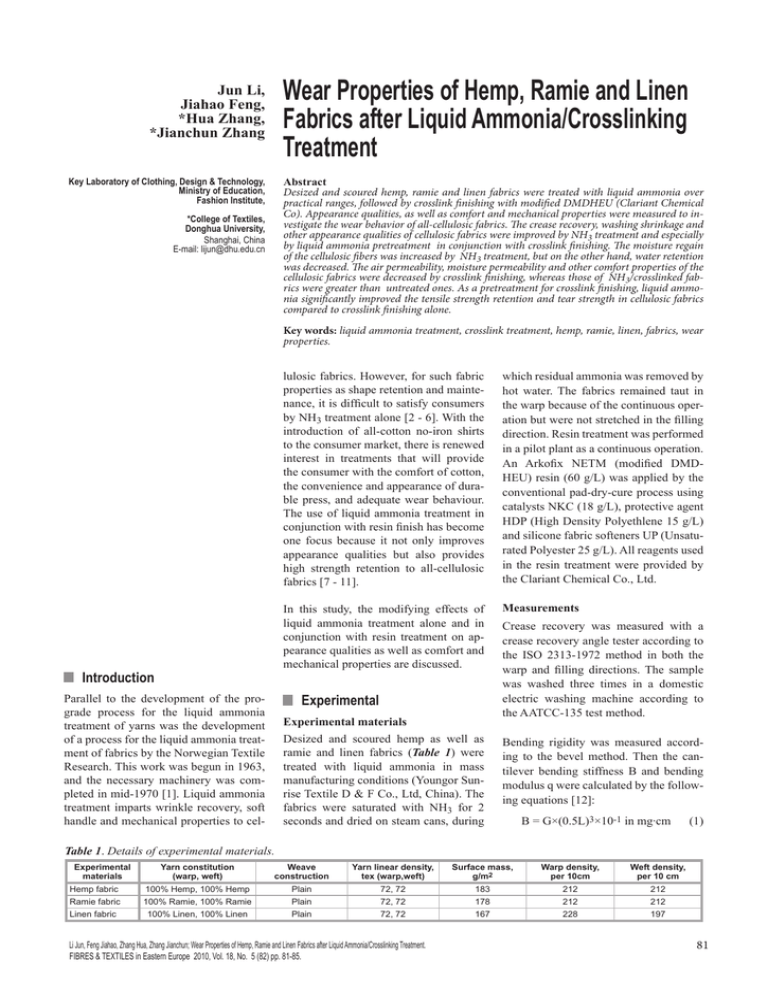Wear Properties of Hemp, Ramie and Linen Fabrics after Liquid Ammonia/Crosslinking Treatment
advertisement

Wear Properties of Hemp, Ramie and Linen Fabrics after Liquid Ammonia/Crosslinking Treatment Jun Li, Jiahao Feng, *Hua Zhang, *Jianchun Zhang Abstract Desized and scoured hemp, ramie and linen fabrics were treated with liquid ammonia over practical ranges, followed by crosslink finishing with modified DMDHEU (Clariant Chemical Co). Appearance qualities, as well as comfort and mechanical properties were measured to investigate the wear behavior of all-cellulosic fabrics. The crease recovery, washing shrinkage and other appearance qualities of cellulosic fabrics were improved by NH3 treatment and especially by liquid ammonia pretreatment in conjunction with crosslink finishing. The moisture regain of the cellulosic fibers was increased by NH3 treatment, but on the other hand, water retention was decreased. The air permeability, moisture permeability and other comfort properties of the cellulosic fabrics were decreased by crosslink finishing, whereas those of NH3/crosslinked fabrics were greater than untreated ones. As a pretreatment for crosslink finishing, liquid ammonia significantly improved the tensile strength retention and tear strength in cellulosic fabrics compared to crosslink finishing alone. Key Laboratory of Clothing, Design & Technology, Ministry of Education, Fashion Institute, *College of Textiles, Donghua University, Shanghai, China E-mail: lijun@dhu.edu.cn Key words: liquid ammonia treatment, crosslink treatment, hemp, ramie, linen, fabrics, wear properties. nIntroduction lulosic fabrics. However, for such fabric properties as shape retention and maintenance, it is difficult to satisfy consumers by NH3 treatment alone [2 - 6]. With the introduction of all-cotton no-iron shirts to the consumer market, there is renewed interest in treatments that will provide the consumer with the comfort of cotton, the convenience and appearance of durable press, and adequate wear behaviour. The use of liquid ammonia treatment in conjunction with resin finish has become one focus because it not only improves appearance qualities but also provides high strength retention to all-cellulosic fabrics [7 - 11]. which residual ammonia was removed by hot water. The fabrics remained taut in the warp because of the continuous operation but were not stretched in the filling direction. Resin treatment was performed in a pilot plant as a continuous operation. An Arkofix NETM (modified DMDHEU) resin (60 g/L) was applied by the conventional pad-dry-cure process using catalysts NKC (18 g/L), protective agent HDP (High Density Polyethlene 15 g/L) and silicone fabric softeners UP (Unsaturated Polyester 25 g/L). All reagents used in the resin treatment were provided by the Clariant Chemical Co., Ltd. In this study, the modifying effects of liquid ammonia treatment alone and in conjunction with resin treatment on appearance qualities as well as comfort and mechanical properties are discussed. Measurements nExperimental Parallel to the development of the prograde process for the liquid ammonia treatment of yarns was the development of a process for the liquid ammonia treatment of fabrics by the Norwegian Textile Research. This work was begun in 1963, and the necessary machinery was completed in mid-1970 [1]. Liquid ammonia treatment imparts wrinkle recovery, soft handle and mechanical properties to cel- Experimental materials Desized and scoured hemp as well as ramie and linen fabrics (Table 1) were treated with liquid ammonia in mass manufacturing conditions (Youngor Sunrise Textile D & F Co., Ltd, China). The fabrics were saturated with NH3 for 2 seconds and dried on steam cans, during Crease recovery was measured with a crease recovery angle tester according to the ISO 2313-1972 method in both the warp and filling directions. The sample was washed three times in a domestic electric washing machine according to the AATCC-135 test method. Bending rigidity was measured according to the bevel method. Then the cantilever bending stiffness B and bending modulus q were calculated by the following equations [12]: B = G×(0.5L)3×10-1 in mg·cm (1) Table 1. Details of experimental materials. Experimental materials Yarn constitution (warp, weft) Weave construction Yarn linear density, tex (warp,weft) Surface mass, g/m2 Warp density, per 10cm Weft density, per 10 cm Hemp fabric 100% Hemp, 100% Hemp Plain 72, 72 183 212 212 Ramie fabric 100% Ramie, 100% Ramie Plain 72, 72 178 212 212 Linen fabric 100% Linen, 100% Linen Plain 72, 72 167 228 197 Li Jun, Feng Jiahao, Zhang Hua, Zhang Jianchun; Wear Properties of Hemp, Ramie and Linen Fabrics after Liquid Ammonia/Crosslinking Treatment. FIBRES & TEXTILES in Eastern Europe 2010, Vol. 18, No. 5 (82) pp. 81-85. 81 Hemp Ramie Linen 250 200 150 100 50 a b c 0 -2 -4 -6 -8 d Figure 1. Crease recovery angles of (a) untreated, (b) NH3 treated, (c) crosslinked, and (d) NH3/crosslinked fabrics. b c Warp d a b c Filling d 240 Hemp Ramie Linen 900 -2 Bending kg.cm Bendingmodulus, modulus( kg/cm2 ) Cantilever bending a Figure 2. Washing shrinkage of (a) untreated, (b) NH3 treated, (c) crosslinked, and (d) NH3/crosslinked fabrics. 1000 Cantileverstiffness, bending stiffness( mg.cmmg·cm) resin finishing agent and allows the diffusion of the cross-linker into the interior of the fibers. Figure 1 also shows that the wet crease recovery of cellulosic fabrics is greater than that of the same sample in dry conditions, indicating that hemp, ramie and linen fabrics have better appearance retention in wet conditions. Hemp Ramie Linen 2 Dry Wet Washing (%)% Washingshrinkage shrinkage, Crease angle,(degree) degree crease recovery recovery angle 300 800 700 600 500 400 300 200 100 0 a b c Hemp Ramie Linen 200 160 120 80 40 0 d a b c d Figure 3. Cantilever bending stiffness of (a) untreated, (b) NH3 treated, (c) crosslinked, and (d) NH3/crosslinked fabrics. Figure 4. Bending modulus of (a) untreated, (b) NH3 treated, (c) crosslinked, and (d) NH3/crosslinked fabrics. where G is fabric weight per unit area in g/m2 and L is fabric slip length in cm water retention were obtained [13, 14]. Air permeability was measured according to the ISO 9237-1995 test method. Moisture permeability was measured by the evaporation method [15]. Tear strength was assessed according to the ASTM D2261 test method. The breaking load and extensibility were assessed according to the ASTM D5035 test method. q = 12B/t3 × 10-3 in kg/cm2 (2) where t is fabric thickness in mm. The fabrics were immersed in water, then centrifuged and dried. Moisture regain and Table 2. Crystallinity of hemp, ramie and linen fibers. n Results and discussion Treatment Hemp Ramie Linen Appearance qualities Control 84.79 84.48 80.33 NH3treated 72.84 76.43 75.86 Figure 1 shows that liquid ammonia treatment increases wrinkle recovery in the fabrics. The loss of moderate to large pores is therefore associated with increased resilience. These pores are voids between elementary fibres or microfibrils, and their loss affects the closer lateral association between microfibrillar units, which is a natural sort of crosslinking via lateral hydrogen bonding. The crease recovery angles of cellulosic fabrics are considerably increased by crosslink finishing and especially by NH3/crosslink finishing. With the increased amorphous region for larger accessible internal volume, liquid ammonia pretreatment increases the number of crosslinked bonds between the fibers and 12 Hemp Ramie Linen Moisture regain (%)% Moisture regain, 10 8 6 4 2 0 a b c d Figure 5. Moisture regain of (a) untreated, (b) NH3 treated, (c) crosslinked, and (d) NH3/crosslinked fabrics. 82 Figure 2 shows that resin treated fabrics have good dimensional stability compared to non-resin treated fabrics. Crosslinked fabrics show a less than 4% shrinkage in the warp and a less than 1% shrinkage in the filling direction. The untreated hemp and linen fabrics have around 7% shrinkage in the warp direction and 5% shrinkage in the filling direction, while the NH3 treated hemp and linen fabrics have around 5.5% washing shrinkage in the warp and 1% extensibility in the filling directions. The fabrics were held taut in the warp direction during the finishing operations but were not stretched in the filling direction, which is reflected in their shrinkage behaviour. As stresses were relieved in laundering, the warp yarns held taut in the finishing operation had greater shrinkage. As for washing shrinkage, however, after liquid ammonia treatment, ramie fabric is different from hemp and linen fabrics. Figure 3 shows the cantilever bending stiffness of hemp, ramie and linen fabrics resulting from NH3 and resin treatments. The cantilever bending stiffness of hemp, ramie and linen fabrics is increased by liquid ammonia treatment, whereas it is decreased by resin treatment because of softeners in the finishing agent. The bending modulus reflects fiber rigidity, which is not affected by fabric thickness. The bending modulus is decreased by NH3 treatment, except for ramie fabric, as shown in Figure 4. For example, the bending modulus of untreated hemp and linen is 175.5 and 163.63 kgf/cm2, after liquid ammonia treatment 157.10 and 128.05 kgf/cm2, and that of NH3/crosslinked fabrics is 112.5 and 115.94 kgf/cm2, respectively. However, the bending modulus of untreated ramie is 121.01 kgf/cm2, reaching 130.32 kgf/cm2 after NH3 treatment and 126.93 kgf/cm2 after NH3/crosslinked treatment. Comfort properties Liquid ammonia treatment not only results in a larger proportion of amorphous regions but also disorders parts of the crystallite region, as shown in Table 2; FIBRES & TEXTILES in Eastern Europe 2010, Vol. 18, No. 5 (82) a) b) c) d) Figure 6. Surface SEM photograph of untreated hemp, ramie and linen fibers; a) Hemp (×2 000), b) Linen (×2 000), c) Ramie (×2 000), Ramie (×5 000). a) b) c) d) Figure 7. Surface SEM photograph of NH3 treated hemp, ramie and linen fibers; a) Hemp (×2 000), b) Linen (×2 000), c) Hemp (×5 000), d) Ramie (×2 000). Waterretention retention,(%) % Water 60 50 40 30 20 10 0 a b c d 1050 80 Hemp Ramie Linen 900 750 600 450 300 150 0 a b c d Moisture permeability, Moisture permeability (%) % Hemp Ramie Linen 70 AirAirpermeabilityd, dcm3)/(m2.s) permeability (L/m2.s 80 Hemp Ramie Linen 70 60 50 40 30 20 10 0 a b c d Figure 8. Water retention of (a) untreated, (b) NH3 treated, (c) crosslinked, and (d) NH3/crosslinked fabrics. Figure 9. Air permeability of (a) untreated, (b) NH3 treated, (c) crosslinked, and (d) NH3/crosslinked fabrics. Figure 10. Moisture permeability of (a) untreated, (b) NH3 treated,(c) crosslinked, and (d) NH3/crosslinked fabrics fibers. hence the moisture regain of hemp, ramie and linen fabrics is increased by NH3 treatment, as shown in Figure 5. The moisture regain of cellulosic fabrics is decreased by crosslink finishing, whereas that of NH3/crosslinked fabrics is greater than untreated ones. Figure 6 also shows that there are many bigger ravines on ramie fibers, making it easier to absorb water from its particular approaches. After liquid ammonia treatment the water retention of hemp and linen fabrics is considerably higher than that of ramie fabrics, as shown in Figure 8, resulting in a decrease in the space for holding water. Hence the water retention of cellulosic fabrics is decreased by NH3 treatment, especially for hemp and linen fabrics. This behaviour is almost the same as that with the NH3 treatment of cotton [13, 14]. For deposited resin in the pores of fibers and on their surfaces, the water retention of crosslinked fabrics became lower, especially cellulosic fabrics after liquid ammonia pretreatment and in conjunction with crosslink finishing. ity of cellulosic fabrics is considerably improved by NH3 treatment, especially hemp fabric. The yarns of cellulisic fabrics became fleecy after swelling treatment and subsequent hot water processing. The reduction in crevices on the fiber surface resulted in increased changes with respect to ventilation. The moisture permeability of hemp, ramie and linen fabrics is improved by the swelling finish, as shown in Figure 10, the reason for which is almost the same as for air permeability in the NH3 treatment of cellulosic fabrics. The air and moisture permeability of cellulosic fabrics are decreased by resin treatment, whereas that of NH3/crosslinked fabrics is still greater than untreated ones. As compared to ramie fiber, hemp and linen fibers are slender, and many of which are oblate. In the same characteristic fabric conditions, there are many more soakage spaces in hemp and linen fabrics than in ramie, which is required for the water retention of all-cellulosic fabrics. What is more, there are many striations, crevices and narrower ravines on the surface of hemp and linen fibers, whereas there are few or none on the surface of ramie fiber, as shown in Figure 6. The number of crevices decreased greatly and the surface of fibers became much smoother after liquid ammonia treatment, as shown in Figure 7. FIBRES & TEXTILES in Eastern Europe 2010, Vol. 18, No. 5 (82) Figure 9 shows the air permeability of hemp, ramie and linen fabrics after NH3 and resin treatments. The air permeabil- Mechanical properties Figure 11 shows the strength at rupture of hemp, ramie and linen fabrics after NH3 and resin treatments. The strength in the warp of cellulosic fabrics is im- 83 Hemp Ramie Linen Differential accessible volume V.lb(ml/g) Strength at rupture (N) 1800 Warp Filling 1500 1200 900 600 300 a b c d Figure 11. Strength at rupture of (a) untreated, (b) NH3 treated,(c) crosslinked, and (d) NH3/crosslinked fabrics crosslinked. Untreated Ramie Treated Ramie 40 35 30 nConclusions 25 20 15 10 5 0 0 20 40 60 80 100 120 140 160 Figure 12. Relationship between the differential accessible volume and diameters of micpores in ramie fiber. Hemp Ramie Linen 56 Warp Filling 40 30 20 40 32 24 16 0 8 b c d Warp Filling 48 10 a Hemp Ramie Linen a b c d Figure 13. Elongation at rupture of (a) untreated, (b) NH3 treated, (c) crosslinked, and (d) NH3/crosslinked fabrics. Figure 14. Tear strength of (a) untreated, (b) NH3 treated, (c) crosslinked, and (d) NH3/crosslinked fabrics. proved, whereas in the filling direction it is decreased by the liquid ammonia treatment. The fabrics were held taut in the warp direction during the finishing operations but were not stretched in the filling direction. According to Koichi Goda and et al [16], it can be concluded that microfibrils with a load application during liquid ammonia treatment become more oriented along the axis of tension, as compared to microfibrils without load application. After crosslink finishing, the strength of crosslinked cellulosic fabrics is considerably decreased. However, NH3/crosslinked cellulosic fabrics have higher strength retention in the warp and filling directions, as compared to fabrics after crosslink finishing alone. fibers more uniform after NH3 treatment. The distribution of resin and crosslinking bonds becomes uniform, leading to improved mechanical properties of cellulosic fabrics. Firstly, the strength in the warp of hemp, ramie and linen fabrics is increased by liquid ammonia treatment, as shown in Figure 11. Secondly, the volume of micropores with a diameter larger than 36Å is decreased by liquid ammonia treatment, while that of micropores smaller than 36Å is increased, as shown in Figure 12 [17]. Liquid ammonia treatment increases the volume of smaller micropores and decreases that of larger ones in ramie fiber. As a result, the size distribution of cellulosic fiber becomes narrow and micropore distribution in the 84 The crease recovery, washing shrinkage, bending modulus and other appearance qualities of hemp, ramie and line fabrics are improved by NH3 treatment, especially by liquid ammonia pretreatment and in conjunction with crosslink finishing. The moisture regain, air permeability and moisture permeability of cellulosic fabrics are all increased by liquid ammonia treatment, whereas they are decreased by crosslink finishing; and those of NH3/ crosslinked cellulosic fabrics are greater than untreated ones. 64 Tearing strength (N) Elongation at rupture (%) 45 Diameter of micpores D(A) 60 50 cellulosic fabrics could be improved by liquid ammonia pretreatment and in conjunction with resin treatment. 50 Figure 13 shows the elongation at rupture of hemp, ramie and linen fabrics after NH3 and resin treatments. Extensibilities in the warp of cellulosic fabrics are decreased a little by NH3 treatment, however, they are considerably increased in the filling direction, which is attributed to the fabrics being held taut in the warp direction and not stretched in the filling direction during liquid ammonia treatment. The elongation at rupture in the two directions of hemp, ramie and linen fabrics undergoes no big changes during resin treatment. Figure 14 shows the tear strength of hemp, ramie and linen fabrics after NH3 and resin treatments. The changes in hemp, ramie and linen fabrics are different in the warp and filling directions after NH3 treatment. The tear strength of hemp and linen fabrics is increased after crosslink finishing, while that of ramie fabric is decreased. In general, the tear strengths of NH3/crosslinked cellulosic fabrics are all greater than the crosslinked ones, indicating that the tear strength of The water retention of hemp, ramie and linen fabrics is decreased by NH3 treatment, especially by liquid ammonia pretreatment and subsequent crosslink finishing. The strength of hemp, ramie and linen fabrics is increased by liquid ammonia treatment with load application. NH3/ crosslinked cellulosic fabrics have higher strength retention in the warp and filling directions, as compared to fabrics after crosslink finishing alone. The tear strength of hemp and linen fabrics is increased after crosslink finishing, while that of ramie is decreased. In general, the tear strength of NH3/crosslinked hemp, ramie and linen fabrics is greater than corresponding untreated ones. References 1.Stevens C, and Roldan L G., Liquid ammonia treatment of textiles, Handbook of fiber science and technology, Chemical Processing of Fibers and Fabrics, Fundamentals and Preparation Part A, Vol. 1 (1983) pp. 170-176. 2.Wakida T., Kida Y., Lee M., Bae S., Yoshioka H., Yanai Y.; Dyeing and Mechanical Properties of Cotton Fabrics Treated with Sodium Hysroxide/Liquid Ammonia/Sodium Hysroxide, Textile Res. J. 70 (2000) pp. 328-332. 3.Wakida T., Hayashi A., Lee M. S., Lee M., Doi C., Okada S., Yanai Y.; Dyeing and Mechanical Properties of Ramie Fabric Treated with Liquid Ammonia, Sen’I Gakkaishi 57 (2001) pp. 148-152. 4.Lee M., Wakida T., Tokuyama T., Doi C., Lim Y. J., Jeon S.; Liquid Ammonia TreatFIBRES & TEXTILES in Eastern Europe 2010, Vol. 18, No. 5 (82) ment of Regenerated Cellulosic Fabrics, Textile Res .J. 75 (2005) pp. 13-18. 5. Wakida T., Kitamura Y., Lee M., Bae S., Chen, M., Yoshioka H., Yanai Y.; Effect of Hot Water Processing on Dyeing and Mechanical Properties of Cotton Treated with Liquid Ammonia and Sodium Hydroxide, Textile Res. J. 70 (2000) pp. 769-774. 6.Wakida T., Hayashi A., Lee M.S., Lee M., Okada S., Yanai Y., Liquid Ammonia Treatment of Lyocell, Sen’I Gakkaishi 57 (2001) pp. 355-358. 7.Raheel M., Lien M. D.; Modifying wear life of all-cotton fabrics. Part I: Liquid ammonia treatment and durable press finish, Textile Res. J. 70 (1982) pp. 493-503. 8.Wakida T., Hayashi A., Saito M., Lee M. S., Lee M., Okada, S., Yanai Y.; Liquid Ammonia Treatment of Polyester/Cotton Fabric, Sen’I Gakkaishi 57 (2001) pp. 60-63. 9.Heap S. A.; Liquid ammonia treatment of cotton fabrics as a pretreatment for easycare finishing, Textile Inst. Ind. 6 (1978) pp. 387-390. 10.Jung H.; Liquid ammonia vs caustic mercerization as a pretreatment for the cotton butadienediepoxide reaction, spectra and microscopic studies, Textile Res. J. 45, (1975) pp. 681-691. 11.Vail S. L., Verburg G. B , Calamari T. A.; Ammonia mercerization improves tensile properties of durable-press cotton chambray, Textile Chem. Color. 7 (1975) pp. 26-27. 12.GUO Ya-lin; Research on the dyeing properties of flax with chemical modified, Tianjing University, (2001) pp. 59-60. 13.Yuichi Yanai, Kunihiro Hamada, Yoshio Shimizu; The liquid ammonia treatment of cotton fibers-Comparison and combination with mercerization using a practical unit, Sen’i Gakkaishi, Vol. 62, No. 4, (2006) pp. 63-88. 14.Yuichi Yanai, Kunihiro Hamada, and Yoshio Shimizu; The liquid ammonia treatment of cotton fibers-The structural changes of cotton fibers under different methods of liquid ammonia removal, Sen’i Gakkaishi, Vol. 61, No. 11, (2005) pp. 36-44. 15.LI Yan; Study on the linen fabric comfort and bacteria repellency, Suzhou University, (2004) pp. 33-35. 16.Koichi G., Sreekala M. S., Gomes A., Kaji T., Ohgi J.; Improvement of plant based natural fibers for toughening green composites - Effect of load application during mercerization of ramie fibers, Composites: Part A, 37, (2006) pp. 2213-2220. 17.HUANG Wen-yu, ZHAO Min, ZHU Hui-zhen, ZHOU Xiang, Structure of ramie treated by liquid ammonia, Journal of Donghua University (Eng. Ed.), Vol 23, No. 1 (2006) pp. 103-170. Received 14.02.2009 INSTITUTE OF BIOPOLYMERS AND CHEMICAL FIBRES LABORATORY OF PAPER QUALITY Since 02.07.1996 the Laboratory has had the accreditation certificate of the Polish Centre for Accreditation No AB 065. The accreditation includes tests of more than 70 properties and factors carried out for: 388 npulps n tissue, paper & board, n cores, n transport packaging, n auxiliary agents, waste, wastewater and process water in the pulp and paper industry. The Laboratory offers services within the scope of testing the following: raw ‑materials, intermediate and final paper products, as well as training activities. Properties tested: n general (dimensions, squareness, grammage, thickness, fibre furnish analysis, etc.), nchemical (pH, ash content, formaldehyde, metals, kappa number, etc.), n surface (smoothness, roughness, degree of dusting, sizing and picking of a surface), n absorption, permeability (air permeability, grease permeability, water absorption, oil absorption) and deformation, n optical (brightness ISO, whitness CIE, opacity, colour), n tensile, bursting, tearing, and bending strength, etc., n compression strength of corrugated containers, vertical impact testing by dropping, horizontal impact testing, vibration testing, testing corrugated containers for signs „B” and „UN”. The equipment consists: nmicrometers (thickness), tensile testing machines (Alwetron), Mullens (bursting strength), Elmendorf (tearing resistance), Bekk, Bendtsen, PPS (smoothness/roughness), Gurley, Bendtsen, Schopper (air permeance), Cobb (water absorptiveness), etc., n crush tester (RCT, CMT, CCT, ECT, FCT), SCT, Taber and Lorentzen&Wettre (bending 2-point method) Lorentzen&Wettre (bending 4-point metod and stiffness rezonanse method), Scott-Bond (internal bond strength), etc., n IGT (printing properties) and L&W Elrepho (optical properties), ect., n power-driven press, fall apparatus, incline plane tester, vibration table (specialized equipment for testing strength transport packages), n atomic absorption spectrmeter for the determination of trace element content, pH-meter, spectrophotometer UV-Vis. Contact: INSTITUTE OF BIOPOLYMERS AND CHEMICAL FIBRES ul. M. Skłodowskiej-Curie 19/27, 90-570 Łódź, Poland Elżbieta Baranek Dr eng. mech., tel. (+48 42) 638 03 31, e-mail: elabaranek@ibwch.lodz.pl Reviewed 22.12.2009 FIBRES & TEXTILES in Eastern Europe 2010, Vol. 18, No. 5 (82) 85






